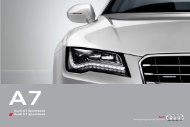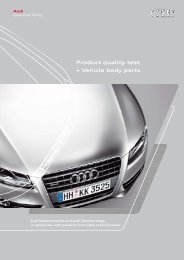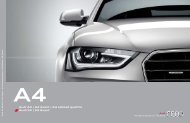A3 Brochure - Audi
A3 Brochure - Audi
A3 Brochure - Audi
Create successful ePaper yourself
Turn your PDF publications into a flip-book with our unique Google optimized e-Paper software.
54<br />
TDI®<br />
TDI ®<br />
The injectors open and close in fractions<br />
of a millisecond and inject fuel<br />
several times into the combustion<br />
chamber at pressures of up to 1,800<br />
bar. In some cases, an injection process<br />
can involve the injection of the<br />
tiniest of amounts weighing less<br />
than a thousandth of a gramme.<br />
Almost one in every two <strong>Audi</strong> cars sold today is a<br />
diesel. What sounds perfectly normal now was<br />
cause for huge excitement a good 20 years ago,<br />
when <strong>Audi</strong> revolutionised the market with the<br />
first 2.5 litre TDI engine. Developments in<br />
technology such as common rail technology have<br />
since made TDI more and more efficient. The<br />
injectors ensure the fuel is finely and precisely<br />
distributed. Consequently, since the first TDI, the<br />
engines have become more economical, whilst<br />
specific output has increased. That’s why it was<br />
only logical for a diesel to enter the world of<br />
motorsport. And successfully too: in 2006,<br />
<strong>Audi</strong> was the first car maker to win the Le Mans<br />
24 Hours with a diesel-powered race car, the<br />
<strong>Audi</strong> R10 TDI – and then went on to repeat this<br />
victory several times over, most recently in 2012.<br />
The diesel engines in the <strong>A3</strong> and <strong>A3</strong> Sportback<br />
will leave you enthralled not only by their engine<br />
power but by their efficiency as well. Their common<br />
rail injection system has four injectors and is<br />
characterised by an excellent balance of performance,<br />
driving comfort and engine acoustics.<br />
The fuel consumption and CO₂ emission figures can be found from page 118 onwards.<br />
Pre-injection results in a “gentle”<br />
combustion process and consequently<br />
excellent combustion acoustics and<br />
agreeable engine running characteristics.<br />
In other words: Where is the tank?<br />
The 1.6 TDI with 77 kW produces 250 Nm of<br />
torque and lets you accelerate the <strong>Audi</strong> <strong>A3</strong> with<br />
manual transmission from 0 to 100 km/h in<br />
10.7 seconds. Yet it only consumes an impressive<br />
average of 3.8 l of fuel over 100 km and has a<br />
combined emission of only 99 g CO₂/km.<br />
The 2.0 TDI with 110 kW and manual<br />
transmission produces 0 to 100 km/h times of<br />
8.6 seconds for the <strong>A3</strong> and 8.7 seconds for the<br />
<strong>A3</strong> Sportback. It also has a highly efficient<br />
thermal management system. Its two balancer<br />
shafts are now directly integrated in the<br />
crankcase, improving the running smoothness<br />
even further. It reaches its maximum torque of<br />
320 Nm at 1,750 rpm. The engine with manual<br />
transmission consumes an average of 4.1 l/<br />
100 km in the <strong>A3</strong> and 4.2 l/100 km in the<br />
<strong>A3</strong> Sportback, and emits only 106 g CO₂/km in<br />
the <strong>A3</strong> and 108 g CO₂/km in the <strong>A3</strong> Sportback<br />
(combined values).















